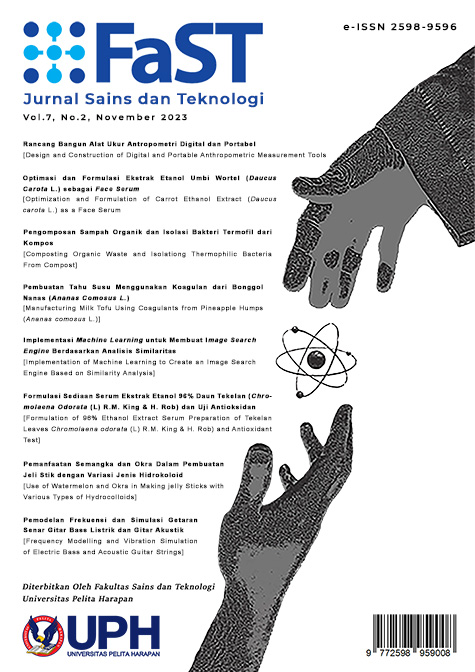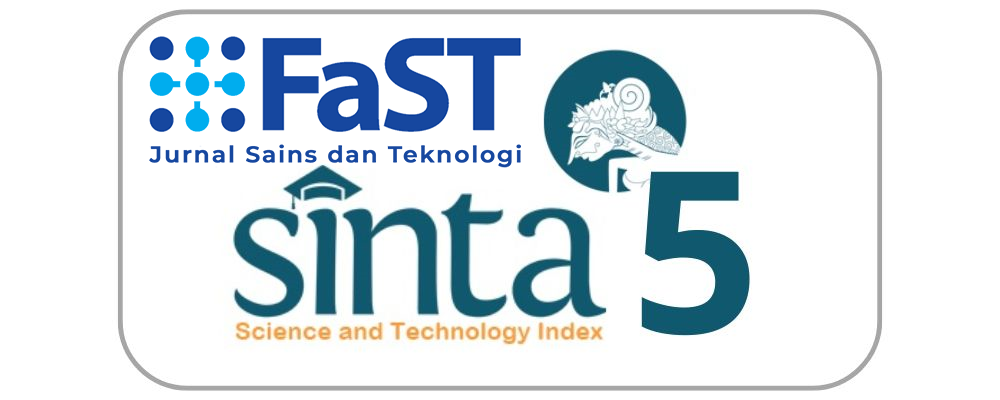PENGOMPOSAN SAMPAH ORGANIK DAN ISOLASI BAKTERI TERMOFIL DARI KOMPOS [COMPOSTING ORGANIC WASTE AND ISOLATING THERMOPHILE BACTERIA FROM COMPOST]
DOI:
https://doi.org/10.19166/jstfast.v7i2.7596Keywords:
Bacillus, trembesi tree, leaves, twigs/branchesAbstract
Composting is one of the methods to sustainably minimize the accumulation of waste in the environment. Compost is made through the decomposition process of organic waste with the help of microorganisms. The process of making compost goes through several phases, one of the most important phases is the thermophilic phase. In this research, an evaluation was carried out on the effect of temperature, humidity, pH and aeration on the success of composting from leaves and twigs and braches of trembesi tree (Albizia saman). In addition, isolation and identification of thermophilic bacteria which play an important role in the composting process were carried out. Isolation of thermophilic bacteria is carried out when the compost making process is in the thermophilic phase. To support the growth of thermophilic bacteria, incubation during the isolation and purification process was carried out at a temperature of as high as 55-60 oC. Subsequently, thermophilic bacterial isolates were identified based on morphology and biochemical activity tests. The characterization results based on Bergey's Manual Systematic Bacteriology Second Edition Volume Three the Firmicutes indicated that the isolates obtained belonged to the genus Bacillus.
Bahasa Indonesia Abstract:
Pembuatan kompos merupakan salah satu cara yang dapat dilakukan untuk meminimalisasi penumpukan sampah di lingkungan secara berkelanjutan. Kompos dibuat melalui proses dekomposisi sampah organik dengan bantuan mikroorganisme. Proses pembuatan kompos melalui beberapa fase, salah satu fase terpenting adalah fase termofilik. Pada penelitian ini, dilakukan evaluasi pengaruh suhu, kelembapan, pH dan aerasi terhadap keberhasilan pembuatan kompos dari daun dan ranting serta dahan pohon trembesi (Albizia saman) Selain itu, dilakukan isolasi dan identifikasi bakteri termofilik yang berperan penting dalam proses pengomposan. Isolasi bakteri termofilik dilakukan saat proses pembuatan kompos berada pada fase termofilik. Untuk mendukung pertumbuhan bakteri termofil, inkubasi selama proses isolasi dan purifikasi dilakukan pada suhu 55-60 oC. Selanjutnya, isolat bakteri termofil diidentifikasi berdasarkan morfologi dan uji aktivitas biokimia. Hasil karakteriasasi yang dicocokan dengan Bergey’s Manual Systematic Bacteriology Second Edition Volume Three the Firmicutes mengindikasikan bahwa isolat yang diperoleh berasal dari genus Bacillus.
References
Agung, K., Juita, E., & Zuriyani, E. (2021). Analisis pengelolaan sampah di Tempat Pembuangan Akhir (TPA) Desa Sido Makmur Kecamatan Sipora Utara. Jurnal Pendidikan dan Ilmu Geografi, 6(2), 115-124. https://doi.org/10.21067/jpig.v6i2.5936
Antunes, L. P., Martins, L. F., Pereira, R. V., Thomas, A. M., Barbosa, D., Lemos, L. N., Silva, G. M. M., Moura, L. M. S., Epamino, G. W. C., Digiampietri, L. A., Lombardi, K. C., Ramos, P. L., Quaggio, R. B., de Oliveira, J. C. F., Pascon, R. C., da Cruz, J. B., da Silva, A. M., & Setubal, J. C. (2016). Microbial community structure and dynamics in thermophilic composting viewed through metagenomics and metatranscriptomics. Scientific Reports, 6(1), 38915. https://doi.org/10.1038/srep38915
Azim, K., Soudi, B., Boukhari, S. Perissol, C. Roussos, S., & Alami, I. T. (2017). Composting parameters and compost quality: A literature review. Organic Agriculture, 8, 141-158. https://doi.org/10.1007/s13165-017-0180-z
Bhattacharya, A., & Pletschke, B. I. (2014). Thermophilic Bacilli and their enzymes in composting. In Maheshwari, D. (eds.) Composting for Sustainable Agriculture: Sustainable Development and Biodiversity (pp 103-124), vol 3. Springer, Cham. https://doi.org/10.1007/978-3-319-08004-8_6
Backhus. (2011). Buku pedoman untuk professional pengomposan. Edewecht: Tim Backhus GmbH Eco Engineers.
Kementrian Lingkungan Hidup dan Kehutanan (KLHK). (2020). Indonesia memasuki era baru pengelolaan sampah. Retrieved July 20, 2021 from http://ppid.menlhk.go.id/siaran_pers/browse/2329
Kong, Z., Wang, X., Wang, M., Chai, L., Wang, X., Liu, D., & Shen, Q. (2020). Bacterial ecosystem functioning in organic matter biodegradation of different composting at the thermophilic phase. Bioresource Technology, 317, 123990. https://doi.org/10.1016/j.biortech.2020.123990
Lopez, M. J., Jurado, M. M., López-González, J. A., Estrella-González, M. J., MartÃnez-Gallardo, M. R., Toribio, A., & Suárez-Estrella, F. (2021). Characterization of thermophilic lignocellulolytic microorganisms in composting. Frontiers in Microbiology, 12, 697480. https://doi.org/10.3389/fmicb.2021.697480
Palaniveloo, K., Amran, M. A., Norhashim, N. A., Mohamad-Fauzi, N., Fang, Peng-Hui, F., Hui-Wen, L., Kai-Lin, Y., Jiale, L., Chian-Yee, M. G., Jing-Yi, L., Gunasekaran, B., & Razak, S. A. (2020). Food waste composting and microbial community structure profiling. Processes, 8(6), 723. https://doi.org/10.3390/pr8060723
Rebollido, R., Martinez, J., Aguilera, Y., Melchor, K., Koerner, I., & Stegmann, R. (2008). Microbial populations during composting process of organic fraction of municipal solid waste. Applied Ecology and Environmental Research, 6(3), 61-67. https://doi.org/10.15666/aeer/0603_061067
Richard, T. L., Hamelers, H. V. M., Veeken, A., & Silva, T. (2002). Moisture relationships in composting processes, compost science & utilization, 10(4), 286-302. http://dx.doi.org/10.1080/1065657X.2002.10702093
Sayara, T., Basheer-Salimia, R., Hawamde, F., & Sanchez, A. (2020). Recycling of organic wastes through composting: Process performance and compost application in agriculture. Agronomy, 10, 1838. http://dx.doi.org/10.3390/agronomy10111838
Setiawan, A. (2021). Membenahi tata kelola sampah nasional. Retrieved May 21, 2022 from https://indonesia.go.id/kategori/indonesia-dalam-angka/2533/membenahi-tata-kelola-sampah-nasional
Downloads
Published
Issue
Section
License
“Authors who publish with this journal agree to the following terms:
1) Authors retain copyright and grant the journal right of first publication with the work simultaneously licensed under a Creative Commons Attribution License (CC-BY-SA 4.0) that allows others to share the work with an acknowledgement of the work's authorship and initial publication in this journal.
2) Authors are able to enter into separate, additional contractual arrangements for the non-exclusive distribution of the journal's published version of the work (e.g., post it to an institutional repository or publish it in a book), with an acknowledgement of its initial publication in this journal.
3) Authors are permitted and encouraged to post their work online (e.g., in institutional repositories or on their website). The final published PDF should be used and bibliographic details that credit the publication in this journal should be included.”



